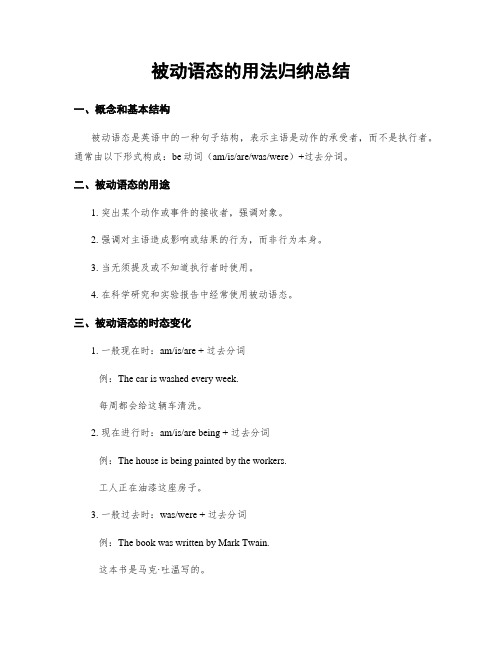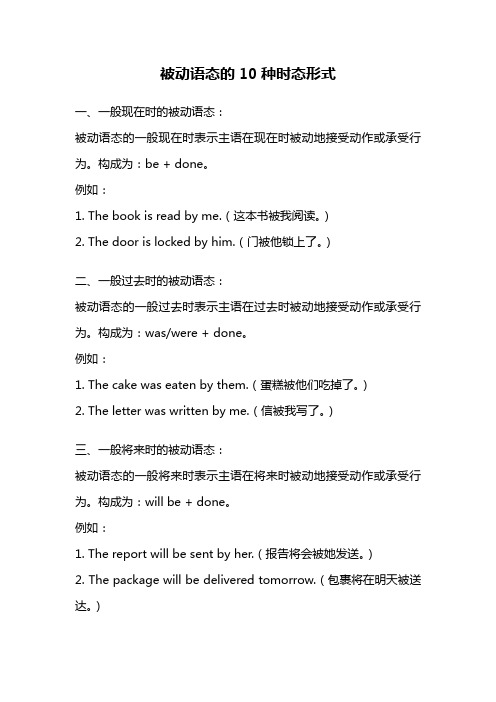2018-2019年英语外研版小学四年级上册现在进行时的被动语态
- 格式:doc
- 大小:35.00 KB
- 文档页数:8

被动语态的用法归纳总结一、概念和基本结构被动语态是英语中的一种句子结构,表示主语是动作的承受者,而不是执行者。
通常由以下形式构成:be动词(am/is/are/was/were)+过去分词。
二、被动语态的用途1. 突出某个动作或事件的接收者,强调对象。
2. 强调对主语造成影响或结果的行为,而非行为本身。
3. 当无须提及或不知道执行者时使用。
4. 在科学研究和实验报告中经常使用被动语态。
三、被动语态的时态变化1. 一般现在时:am/is/are + 过去分词例:The car is washed every week.每周都会给这辆车清洗。
2. 现在进行时:am/is/are being + 过去分词例:The house is being painted by the workers.工人正在油漆这座房子。
3. 一般过去时:was/were + 过去分词例:The book was written by Mark Twain.这本书是马克·吐温写的。
4. 过去进行时:was/were being + 过去分词例:The crops were being harvested when the storm hit.暴风雨袭击时农作物正在收割。
5. 一般将来时:will be + 过去分词例:The package will be delivered tomorrow.这个包裹明天将被送到。
6. 现在完成时:has/have been + 过去分词例:The problem has been solved by our team.这个问题已经被我们的团队解决了。
四、主动语态和被动语态的转换1. 主动语态变被动语态把主动句的宾语移到前面作为被动句的主语,谓语动词改为相应形式的be动词,原主语成为介词by后的短语(可省略)。
例:Active: They built a new bridge last year.被动:A new bridge was built by them last year.2. 被动语态变主动语态将被动句的主语转化为主格作为主句的主语,谓语使用与原句中be表达时态、人称和数一致的动词原形。

高一B2U4语法----现在进行时被动语态本单元的语法是现在进行时态的被动语态,现就其用法归纳如下:一、现在进行时态的被动语态的基本结构的构成:1.现在进行时态的被动语态的肯定式为:am/is/are + being + done。
如:The question is being discussed at the meeting now.这个问题现在正在会上被讨论。
Another bridge is being built over the Changjiang River at present.目前长江上正在建造另一座大桥。
2.现在进行时态的被动语态的否定式为:am/is/are + not + being + done。
如:The baby isn’t being taken good care of. 这婴儿没在得到很好的照顾。
The animals are not being set free at present. 目前这些动物还不能被放出。
3.现在进行时态的被动语态的一般疑问句需将am/is/are 提到主语的前面。
(回答用yes或no)如:---Is a new library being put up in their school now?---Yes, it is.甲:他们学校现在正在建一座新图书馆吗。
乙:是,正在建一座新图书馆---Are a number of Dongfeng trucks being shipped abroad? ---No, they aren’t.甲:一批东风卡车正被运往国外吗?乙:不,没有。
4.现在进行时态的被动语态的特殊疑问句为:疑问词+ am/is/are + (主语) + being + done。
如:What is being done to the machine? 现在对这台机器要采取什么措施?How many houses are being built in the village? 村里正在建造多少房屋?When is the sports meeting being held in our school. 我校将在什么时候举行运动会?二、现在进行时态的被动语态的用法:1.现在进行时态的被动语态的同它的主动语态一样,表示现在正在进行的被动动作。

外研版小学四年级英语现在进行时知识点
现在进行时态讲解:
现在进行时:表示正在进行的或正在发生的动作。
标志词:now ,look ,listen
3.句子的结构如下:be+动词ing (be的三种形式:am , is , are)
例如:(1). I am listening to the music now .
(2).The children are drawing pictures now.
(3).Listen!She is singing.
(4).Look!Mr Li is playing games.
肯定句:主语+be+动词ing+--- 例: She is singing 否定句:
主语+be+not+动词ing+--- 例: She is not singing
一般疑问句:Be+主语+动词ing+---例:Is she singing ?
特殊疑问句:特殊疑问词+be+主语+动词ing+--?
例:What is she doing?
4.动词的ing形式有如下方法:
A.一般情况在动词后直接加ing: go—going; wash—washing fly—flying
B.以不发音的e结尾,去掉e加ing: drive—driving; ride —riding
C.某些单词要双写词尾的字母:swim—swimming; run—running
下列单词要双写:get(得到) forget(忘记) put (放cut(切)sit (坐) skip(跳绳)
shop(购物)stop (停)begin(开始)run(跑)swim(游泳)dig(挖)。

现在进行时的被动语态引言被动语态是英语中常用的语法结构之一,它使得句子的主语成为动作的承受者,而不是执行者。
在现在进行时态中,被动语态的构成略有不同。
本文将介绍现在进行时的被动语态的构成方式、用法和一些常见的例句。
现在进行时的被动语态的构成方式现在进行时的被动语态是由be动词加上动词的现在分词构成的。
其中,be动词的形式根据句子的主语和时态来变化,而动词的现在分词形式则保持不变。
具体而言,现在进行时的被动语态的构成方式如下: - 肯定句:主语 + am/is/are + being + 过去分词 - 否定句:主语 + am/is/are + not + being + 过去分词 - 疑问句:Am/Is/Are + 主语 + being + 过去分词 + ?现在进行时的被动语态的用法现在进行时的被动语态主要用于以下情况: 1. 当强调动作的接收者时,可以使用被动语态。
例如: - The cake is beingbaked by my mother.(蛋糕正在被我妈妈烤。
) - The letter is being written by John.(这封信正在被约翰写。
) 2. 当不知道或不关心动作的执行者时,也可以使用被动语态。
例如: - The car is being repaired.(这辆车正在被修理。
) - The house is being cleaned.(这个房子正在被清洁。
) 3. 当描述某个动作正在进行时,但又不想明确指明执行者时,也可以使用被动语态。
例如: - The project is being discussed.(这个项目正在被讨论。
) - The decision is being made.(这个决定正在被做出。
)现在进行时的被动语态的例句以下是一些使用现在进行时的被动语态的例句:1.The book is being read by many people.(这本书正被很多人阅读。

被动语态的10种时态形式一、一般现在时的被动语态:被动语态的一般现在时表示主语在现在时被动地接受动作或承受行为。
构成为:be + done。
例如:1. The book is read by me.(这本书被我阅读。
)2. The door is locked by him.(门被他锁上了。
)二、一般过去时的被动语态:被动语态的一般过去时表示主语在过去时被动地接受动作或承受行为。
构成为:was/were + done。
例如:1. The cake was eaten by them.(蛋糕被他们吃掉了。
)2. The letter was written by me.(信被我写了。
)三、一般将来时的被动语态:被动语态的一般将来时表示主语在将来时被动地接受动作或承受行为。
构成为:will be + done。
例如:1. The report will be sent by her.(报告将会被她发送。
)2. The package will be delivered tomorrow.(包裹将在明天被送达。
)四、现在进行时的被动语态:被动语态的现在进行时表示主语在现在进行时被动地接受动作或承受行为。
构成为:am/is/are being + done。
例如:1. The car is being washed by the workers.(汽车正在被工人清洗。
)2. The project is being discussed by the team.(项目正在被团队讨论。
)五、过去进行时的被动语态:被动语态的过去进行时表示主语在过去进行时被动地接受动作或承受行为。
构成为:was/were being + done。
例如:1. The house was being renovated last month.(房子上个月正在进行装修。
)2. The document was being translated by the intern.(文件正在被实习生翻译。

现在进行时被动语态主要用来表示现在某个被动的动作正在进行中,主语是动作或者状态的承受者。
现在进行时的被动语态基本结构是:主语+be(is、am、are)+ being+动词的过去分词+其他。
比如:The car is being driven by me。
(现在我在驾驶这辆汽车)。
在英语中,现在进行时的被动语态是学习语法的一个难点,很多孩子对如何使用感到困惑。
现在进行时中的被动语态主要用来表示被动动作正在进行中。
当我们理解它的时候,我们必须把被动语态变成主动语态来理解它。
翻译现在进行时的被动语态时,也要转换成主动语态。
现在进行时被动语态的肯定结构是:主语+be(is、am、are)+ being+动词的过去分词+其他。
下面我们看一下现在进行时被动语态是如何在句子中使用的。
1)、Smell, the delicious meat is being cooked by my mother in the kitchen. 你闻,我妈妈正在厨房做美味的肉。
2) Look, the little cat is being taken good care by the beautiful girl. 你看,这个漂亮的女孩正在细心地照料这只小猫。
3)、The essay is being writen by the teacher in the class. 老师正在教室里写文章。
4)、The animal is being protected by the pliceman in the law. 在法律上警察是要保护动物的。
5)、The travel plan is being done by my mother in my bedroom. 妈妈正在我的房间里作这次旅行的计划。
6)、The picture is being showed by the school in the wall. 学校在墙上展示了这幅画。
现在进行时的被动语态现在进行时的被动语态由“be bein g+及物动词的过去分词”构成, 助动词be有人称和数的变化(am, is are ).1.表示此刻正在进行的被动动作。
The project is being discussed at the meeting.A new film is being shown in the theater.My house is being painted now.2.表示现阶段正在进行的被动动作,但此动作不一定在此时此刻发生。
Many interesting experiences are being carried out these days.A modern school is being built in our hometown.A computer center is being built for the students?3.表示经常的被动行为,常和always, often, constantly 等词连用。
(表达某种感情色彩)He is always being praised by the teacher.一. 注意不可遗漏being现在进行时的被动语态表示说话时正在进行的一个被动的动作,强调主语是动作的承受者,其构成为“am / is / are + being+动词的过去分词”。
如果我们把being漏掉,就成为一般现在时的被动语态或系表结构。
如: Look! The children are being taken care of by their aunt. 瞧!那些孩子正由他们的姑妈照看着。
区别:Children are taken good care of at school. 孩子们在学校被照看得很好。
(指通常情况) 二. 注意不可忽视“现阶段”现在进行时的被动语态也可表示目前这一阶段正在进行的一个被动的动作。
如: Many interesting experiments are being carried out these days.如今许多有趣的实验正在被进行着。
语法构成现在进行时的构成是: +be+v.ing〔现在分词〕形式:主语+be+现在分词+其他.:主语+be+not+现在分词+其他.:Be+主语+现在分词+其他.: + +主语+现在分词+Sth.+其他?变化规则1.直接+ (例:sleep+ing=sleeping)2.去掉不发音的e+ing(例:bite-e+ing=biting)3.,以加结尾的词,要双写尾字母再加ing(例:swim+m+ing=swimming)travel除外构成4.以ie结尾的重读闭音节,变ie为y+ing (例:die-dying lie-lying)5结尾为c且c读作/k/时,在结尾加k再加ing (例:picnic-picnicking)现在进行时的基本用法:A表示现在( 指说话人说话时) 正在发生的事情。
例:We are waiting for you.B. 表示现阶段正在进行的动作,说话时未必正在进行。
例:Mr. Green is writing another novel.(说话时并未在写,只处于写作的状态。
)例:She is learning Mr. Smith.C.已经确定或安排好的但不确定会不会发生的将来活动。
I'm leaving for a travel in Nepal next week.(我下周要去旅行)We're flying to Paris tomorrow句型构成现在进行时be+动词的(ing形式)。
be的变化在现在时中,be 要根据和名词的单复数不同,而分别使用am/is/are,即:I am/he/she/it 包括单数名词和用is,you/we/they 包括用are.现在进行时注意:be 动词在现在时里算作“助动词”,翻译正在进行时的时候,be不能解释为“是”,否则不通顺。
它只是和现在分词一起构成“进行时”。
动词加ing的规则现在分词是在动词后加上ing 构成。
英语作文现在进行时的被动语态IntroductionThe present continuous tense is used to describe actions or situations that are happening at the moment. When combined with the passive voice, it becomes a powerful tool to express situations where something is currently being done or experienced by someone or something else.Structure of the Present Continuous Tense in the Passive VoiceThe present continuous tense in the passive voice follows a specific structure: "am/is/are + being + the past participle of the verb". This construction indicates that the action described by the verb is currently taking place and is not initiated by the subject of the sentence, but by an agent implied or mentioned elsewhere in the text.Examples of the Present Continuous Tense in the Passive Voice1."The house is being painted by the workers right now."2.In this example, the action of painting is currently happening, and it isbeing done by the workers. The subject "the house" is the recipient of the action.3."The project is being discussed in the meeting at the moment."4.Here, the project is the recipient of the discussion that is taking placeduring the meeting. The action of discussing is ongoing and is being performed by unknown agents.5."The movie is being watched by everyone in the cinema."6.In this sentence, the movie is the recipient of the watching action, whichis currently happening and is being done by "everyone in the cinema."Uses of the Present Continuous Tense in the Passive VoiceThe present continuous tense in the passive voice is often used in news reports to describe events that are unfolding in real-time. It can also be employed in narrations or stories to give the reader a sense of immediacy and active participation. It can also be used to describe temporary situations or ongoing processes that are not initiated by the subject.ConclusionThe present continuous tense in the passive voice is a valuable tool for English writers, as it allows them to communicate situations where actions or states are currently being experienced by someone or something else in a clear and engaging manner. With practice and attention to the specificconstruction of this tense, writers can convey the immediacy and temporariness of these actions or states effectively.。
被动语态编辑现在进行时由主动语态变被动语态时应注意以下一些问题:1、也像其它时态由主动语态变被动语态一样,首先弄清楚用现在进行时的句子中哪些可以由主动语态变为被动语态。
我们知道,在简单句的五个基本句型中,有三个基本句型(S V O,S V o O,S V O C)可以由主动语态变为被动语态;有两个基本句型(S V,S V P)不能由主动语态变为被动语态。
所以,当这三个基本句型(S V O,S V InO DO,S V O OC)的谓语动词用了现在进行时时才有可能由主动语态变为被动语态。
例如:还应注意到一些动词很少用于被动语态,因此这些动词在句子谓语用了现在进行时时也常没有被动语态。
如:We are having supper now。
一般不能变为Supper is being had now。
2、及物动词现在进行时由主动语态变被动语态时有三种句式:①主语(第一人称单数I)am being过去分词其他成分;②主语(第二人称单、复数you,第一人称复数we和第三人称复数they等)are being 过去分词其他成分;③主语(第三人称单数 he,she,it等)is being 过去分词其他成分。
所以,当句子谓语动词用了现在进行时由主动语态变被动语态时谓语动词要由原来作宾语变为主语时的名(代)词的数来决定,从上面三种句式中选择合适的一种句式。
例如:They are collecting money for the broadband project.→3、当变为主语的原来的宾语(名/代词)有较长的动词不定式短语(复合结构)、介词短语、从句修饰或有补足语时,动词不定式短语、介词短语、从句和补足语等,一般都仍然保留在原来的位置上。
例如:They are revising the laws to protect the rights of women and children.→4、如果用在现在进行时的句子中的谓语动词是动词短语或习惯用语,那么这个动词短语或习语只把动词变为被动语态,其他部分保持不变。
例如:The parents are taking good care of their test-tube baby.→5、当用了现在进行时的句子结构是"S V In O DO"句型时,既可以把间接宾语变为被动句的主语,也可以把直接宾语变为被动句的主语,但如果是后者,可根据动词的习惯用法,把间接宾语改写为to 或for引起的介词短语。
6、用了现在进行时的句子由主动语态变为被动语态后,原来充当主语的名/代词(特别是人称代词)在一般情况下可以省略掉,如果有必要强调时可用by表示,常放在句子后面。
例如:They are adding new functions to the phones.7、当用了现在进行时的句子由主动语态变为被动语态后,其否定式的构成主要把not放在谓语动词中第一个助动词(am ,are或is)后面构成,而疑问式的构成则是把句子谓语动词的第一个助动词(am,are或is)移到句子前(第一个字母要大写),然后在句子后面加上问号而成。
例如:New nature parks are being started in China.New nature parks are not being started in China.(否定式)Are milu deer being sent to China from Britain?(疑问式)如果是特殊疑问句还要在这个助词前面加上适当疑问词。
例如:Why is money being collected?与一般现在时区别现在进行时与一般现在时的区别(一)现在进行时表示动作的暂时性,而一般现在时表示动作的习惯性和经常性I am watching TV now. (暂时性)I watch TV every day. (经常性)(二)有的现在进行时句子和一般现在时同义。
用现在进行时表示问者的关切心情。
How are you feeling today? (How do you feel today?)你今天感觉如何?(三)现在进行时可表示短暂性动作,而一般现在时表示长久性动作。
Lucy is living in Beijing.(短时间居住)Lucy lives in Beijing. (长久性居住)(四)现在进行时表示的动作可带有感情色彩,而一般现在时所表述的动作通常是事实。
You’re always forgetting the most important things. (责备)He is always helping others. (赞扬)He often helps others. (事实)(五)有些动词不能用进行时,know,understand,love,like,hate,wish,want,think,hope,have,believe,agree,hear,see,notice,等等。
这些动词通常用一般现在时表示说话时发生的动作。
I have a lot of friends here.注意:He is falling and downstairs。
(他正在从楼上摔下来)如果有人说摔下来是一瞬间的事不能用现在进行时是不对的,因为我们描述的是他正在摔下来,而不是要已经摔下来了。
基本用法(1)现在进行时主要表示说话人的说话时刻正在进行的动作、不断重复的动作或目前这个阶段(不一定是说话时刻)正在进行的动作:We’re having a meeting. 我们在开会。
(说话时正在进行的动作)Be quiet! The baby is sleeping. 安静,孩子在睡觉。
He is teaching in a middle school. 他在一所中学教书。
(目前阶段在进行的动作)(2)也可表示当前一段时间内的活动或现阶段正在进行的动作。
(3)现在进行时态的肯定式、否定式、疑问式及简略回答。
1)肯定式:be+v-ing She is singing in the next room.2)否定式:be+not+v-ing The students aren’t cleaning the room.3)一般问句:be动词提前。
肯定答语Yes,主语+be,否定答语No,主语+be not。
4)特殊疑问句:对谓语动词进行提问的:What+be +主语+doing+其他?对其他成份进行提问的,疑问词+一般疑问句?其他用法(1)当句子中有now时,经常表示动作正在进行,这时要用现在进行时。
如:They are playing basketball now. 现在他们正在打篮球。
(2)以look,listen开头的句子,提示我们动作正进行,这时要用现在进行时。
如:Listen!She is singing an English song. 听,她正在唱英语歌。
(3)表示当前一段时间或现阶段正在进行的动作,且此时有this week,these days等时间状语,这时常用现在进行时。
如:We are making model planes these days.这些天我们在做飞机模型。
(4)描述图片中的人物的动作,也为了表达更生动。
此时也常用现在进行时。
如:Look at the picture. The children are flying kites in the park.看这幅图,那些孩子正在公园放风筝。
(5)现在进行时表将来(摘自英语语法网)现在进行时表将来,主要表示按计划或安排要发生的动作:I’m leaving tomorrow. 我明天走。
They’re getting married next month. 他们下个月结婚。
现在进行时与一般现在时均可表示将来,区别是:用现在进行时表示将来,其计划性较强,并往往暗示一种意图;而一般现在时表示将来,则其客观性较强,即通常被视为客观事实,多指按时刻表或规定要发生的情况:I’m not going out this evening. 今晚我不准备出去。
What time does the train leave? 火车什么时候开?(6)现在进行时表示感情色彩现在进行时有时可表示满意、称赞、惊讶、厌恶等感情的色彩,通常与 always, forever, constantly, continually等副词连用。
比较:She’s always helping people. 她老是帮助别人。
(表赞扬)She always helps others. 他总是帮助别人。
(陈述一个事实) The boy is constantly lying. 这孩子老是撒谎。
(表示厌恶) The boy often lies. 这孩子常撒谎。
(指出缺点)(7)动词be的现在进行时摘自英语语法网主要用于表示一时的表现或暂时存在的状态。
比较:He is foolish. 他很傻。
(生性如此)He is being foolish. 他显得很傻。
(指一时的表现,并非总是如此)He is friendly. 他很友好。
(长期如此)He is being friendly. 他显得很友好。
(指暂时的表现,而且不一定真诚)【注】“be+形容词”用于现在进行时时,其中的形容词通常只能是angry, careful, careless, clever, foolish, stupid, kind, friendly, brave, rude, polite等动态形容词,而big, tall, beautiful 等静态形容词不能这样用的。
(8)在口语中表示主语计划将要作的动作。
They are leaving for New York tomorrow. 明天他们将要动身前往纽约。
Is your brother departing soon? 你的兄弟很快就要启程吗?这类情况常与come来,go去, leave离开,depart离开,arrive 到达,stay逗留,start开始等动词连用。
所用的动词必须是动作而不是状态,主语必须是人。
(10)有的动词用于现在进行时表示“逐渐”的含义。
此种用法除了偶尔和now连用外,一般不和其他时间副词连用的。
Our study is becoming more interesting. 我们的学习变得越来越有趣了。
The leaves are turning red. 树叶渐渐地变红了。
适合于此种用法的动词有:bet/grow/become/turn/run/go变成,begin开始,forget忘记,remember记得,die死,finish完成,find发现,rise增强等.(11)be动词的现在进行时。